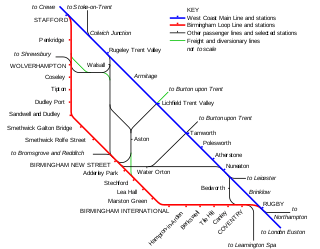Rugby–Birmingham–Stafford Line
| Rugby–Birmingham–Stafford Line (Birmingham Loop Line) | |
|---|---|
|
Diagrammatic map of the route in red. | |
| Overview | |
| Locale |
West Midlands (region) |
| Termini |
Rugby Stafford |
| Stations | 21 |
| Operation | |
| Opened | 1852 (complete route) |
| Owner | Network Rail |
| Technical | |
| Track gauge | 1,435 mm (4 ft 8 1⁄2 in) standard gauge |
The Rugby–Birmingham–Stafford Line (also known as the Birmingham Loop Line[1]) is a railway line in the West Midlands of England. It is a loop off the West Coast Main Line (WCML) between Rugby and Stafford via the West Midlands cities of Coventry, Birmingham and Wolverhampton. The direct route between Rugby and Stafford is the Trent Valley Line.
Places served
The cities, towns and villages served by the line are listed below.
- Stafford
- Penkridge
- Wolverhampton
- Coseley
- Tipton
- Dudley Port High Level - Proposed interchange for the Midland Metro
- Sandwell
- Smethwick
- Birmingham
- Adderley Park (serving Saltley)
- Stechford
- Lea Hall
- Marston Green
- Birmingham International - for National Exhibition Centre and Birmingham International Airport
- Hampton-in-Arden
- Berkswell
- Tile Hill
- Canley
- Coventry
- Rugby
Services
A mixture of intercity, regional, cross-country and local services operate over all or parts of the route. Virgin Trains, London Midland, Arriva Trains Wales and CrossCountry all operate services.
- Virgin Trains use the route as part of their intercity service between London Euston and Birmingham New Street, some services are also extended to/from Wolverhampton, Holyhead or Scotland.
- London Midland also operate London-Birmingham regional trains over the route, all operating via Northampton. They also operate a Birmingham-Liverpool Lime Street service over the route, and local services between Northampton and Birmingham, they also operate local services between Birmingham, Wolverhampton and Shrewsbury.
- Arriva Trains Wales operate regional services between Birmingham International and various destinations in Wales via Shrewsbury.
- CrossCountry use part of the route for their service from Manchester Piccadilly to destinations in the south of England. Many trains on this route run via Wolverhampton, Birmingham and Coventry, turning off to Leamington Spa.
History
- The line from Rugby to Birmingham was opened as part of the London and Birmingham Railway, in 1838, and originally ran into its terminus at Birmingham Curzon Street.
- The Grand Junction Railway opened its line into Curzon Street the following year, linking Birmingham to Wolverhampton, Stafford, and north to the Liverpool and Manchester Railway. However, this line ran via Aston to Wolverhampton (see map). The London and Birmingham, and Grand Junction railways merged in 1846, to form the London and North Western Railway (LNWR). Soon after, work started on building a new, more centrally located station in Birmingham, which became known as Birmingham New Street station.
- Finally, on 1 July 1852, the Stour Valley Line from Wolverhampton to Birmingham via Smethwick opened, from Bushbury, just north of Wolverhampton (where it joined the Grand Junction Railway) to Birmingham New Street. It was promoted by the Birmingham, Wolverhampton and Stour Valley Railway, which was soon absorbed by the LNWR.[2][3]
The LNWR itself became part of the London, Midland and Scottish Railway (LMS) in 1923, and part of British Railways at Nationalisation in 1948.
The line was electrified along with the rest of the WCML during the late 1960s in the wake of the BR 1955 Modernisation Plan.
In 1987, British Rail commissioned artist Kevin Atherton to produce a series of sculptures to be erected along the line between Birmingham New Street station and Wolverhampton. The finished piece was titled Iron Horse, and consists of twelve different horse silhouettes, fashioned from steel. The construction material was chosen for its historic associations with the Black Country.[4][5]
Many of the smaller stations on the line, were closed in the 1950s and 60s, especially between Birmingham and Wolverhampton. However, some new stations were opened in the late 20th century: Birmingham International station was opened in 1976 to serve Birmingham Airport and the National Exhibition Centre, and in 1995 another new station; Smethwick Galton Bridge was opened, serving as a two-level interchange with trains on the Birmingham Snow Hill to Worcester Line.[6]
Accidents
- 1967 - Stechford rail crash; 9 killed, 16 injured.
Infrastructure
Despite the heavy traffic carried by the line, it is only double track throughout, and heavily congested, especially on the stretch between Coventry and Birmingham. In the 1930s, the London, Midland and Scottish Railway (LMS) started work on quadrupling the line between Coventry and Birmingham, however only preparatory work was carried out before the scheme was cancelled due to the outbreak of World War II.[7] Periodic calls have been made since to quadruple the line between Coventry and Birmingham to ease congestion.[8]
The line is electrified with overhead wires at 25kv AC.
References
- ↑ Network Rail Route 17 PDF
- ↑ Tipton Civic Society - Brief History of Tipton
- ↑ "Rugby to Wolverhampton". Warwickshire Railways. Retrieved 1 October 2015.
- ↑ Public Sculpture of Birmingham including Sutton Coldfield, George T. Noszlopy, edited Jeremy Beach, 1998, ISBN 0-85323-692-5
- ↑ "Where Black Country railway horse sculptures came from". bbc.co.uk. BBC. 13 March 1987. Retrieved 15 January 2015.
- ↑ "Smethwick Galton Bridge Station 1995 - Present". Rail Around Birmingham and the West Midlands. Retrieved 4 September 2015.
- ↑ "Canley Halt". Warwickshire Railways. Retrieved 1 October 2015.
- ↑ "Centro: Work to solve Birmingham and Coventry rail bottleneck needed in addition to high speed rail". Global Rail News. 16 February 2011. Retrieved 1 October 2015.
- Jowetts Railways Centres Volume 1, Alan Jowett (PSL, 1993)
- A Century of Railways Around Birmingham and the West Midlands, Volumes 1, 2 & 3, John Boynton (Mid England Books, 1997-1999)
- Rail Atlas of Great Britain and Ireland, S K Baker (OPC, 2004)
External links
| Wikimedia Commons has media related to Rugby-Birmingham-Stafford Line. |

